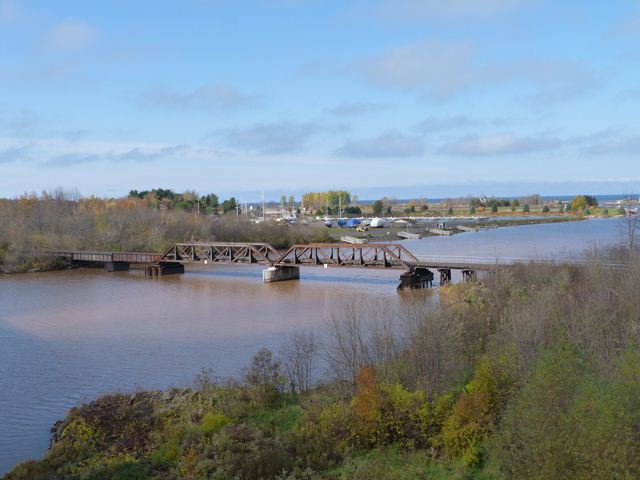We Recommend:
Bach Steel - Experts at historic truss bridge restoration.
Ontonagon Railroad Bridge

Primary Photographer(s): Nathan Holth
Bridge Documented: October 1, 2012
Railroad (Escanaba and Lake Superior Railroad) Over Ontonagon River
Ontonagon: Ontonagon County, Michigan: United States
Metal 6 Panel Pin-Connected Pratt Full-Slope Pony Truss, Fixed and Approach Spans: Metal Deck Girder, Fixed
1899 By Builder/Contractor: Lassig Bridge and Iron Works of Chicago, Illinois
Not Available or Not Applicable
100.0 Feet (30.5 Meters)
470.0 Feet (143.3 Meters)
15 Feet (4.57 Meters)
2 Main Span(s)
Not Applicable

View Information About HSR Ratings
Bridge Documentation
This bridge was originally built for the Chicago, Milwaukee, and St. Paul Railroad. Pony truss bridges are uncommon on railroads, with through truss bridges and plate girders being far more common. As such, this bridge stands out as unusual, and even more so because it has two pony truss spans. With an 1899 construction date and pin connected trusses, the trusses are older examples among Michigan railroad truss bridges, and the pin connections speak to an earlier generation of railroad bridge design.
West of the pony truss spans are five steel deck plate girder approach spans totaling 130 feet in length. The two eastern spans are the largest of these, and the easternmost span is unusual because the girders come up to the track level, rather than completely hiding under the deck like a normal deck plate girder (and the other deck girder spans on this bridge). This easternmost span is also not symmetrical, with the eastern end's bottom chord sloping upward at the end. East of the central pony truss spans is a series of timber stringer approach spans totaling 150 feet in length. At the eastern end, the railroad splits to the north and south in a Y formation. The bridge appears to retain good historic integrity with no major alterations noted. The pony truss spans are outstanding examples of railroad pony truss bridge construction.
The reality that railroad pony truss bridges are far less common than highway pony truss bridges is quite striking. A potential reason for their limited use on railroads is detailed in The Principal Professional Papers of Dr. J. A. L. Waddell, Edited by John Lyle Harrington, dated 1905. The exact text from a discussion of railway bridges follows:
"The pony truss for railway bridges has happily fallen into oblivion. Its top chord was rarely well stayed and was often subjected to severe and unknown stresses, while the economy involved in its use was very small."
It would appear that the specific variety of stresses that a train puts on a railroad bridge were too great for the top chord of a pony truss. In contrast, a through truss with its extensive overhead bracing system must have provided the stability against these stresses.
![]()
Photo Galleries and Videos: Ontonagon Railroad Bridge
Bridge Photo-Documentation
Original / Full Size PhotosA collection of overview and detail photos. This gallery offers photos in the highest available resolution and file size in a touch-friendly popup viewer.
Alternatively, Browse Without Using Viewer
![]()
Bridge Photo-Documentation
Mobile Optimized PhotosA collection of overview and detail photos. This gallery features data-friendly, fast-loading photos in a touch-friendly popup viewer.
Alternatively, Browse Without Using Viewer
![]()
Maps and Links: Ontonagon Railroad Bridge
Coordinates (Latitude, Longitude):
Search For Additional Bridge Listings:
Bridgehunter.com: View listed bridges within 0.5 miles (0.8 kilometers) of this bridge.
Bridgehunter.com: View listed bridges within 10 miles (16 kilometers) of this bridge.
Additional Maps:
Google Streetview (If Available)
GeoHack (Additional Links and Coordinates)
Apple Maps (Via DuckDuckGo Search)
Apple Maps (Apple devices only)
Android: Open Location In Your Map or GPS App
Flickr Gallery (Find Nearby Photos)
Wikimedia Commons (Find Nearby Photos)
Directions Via Sygic For Android
Directions Via Sygic For iOS and Android Dolphin Browser
USGS National Map (United States Only)
Historical USGS Topo Maps (United States Only)
Historic Aerials (United States Only)
CalTopo Maps (United States Only)

